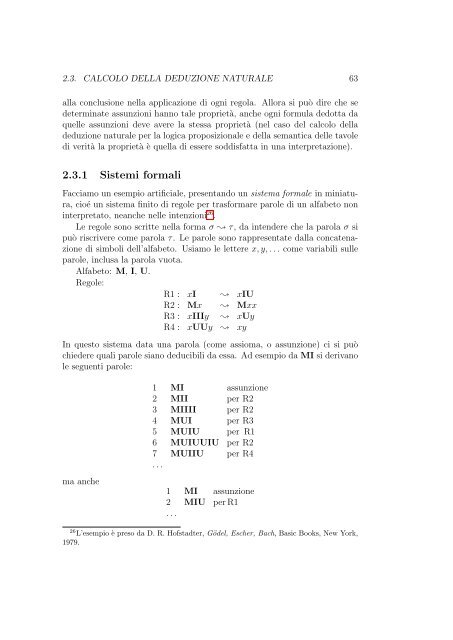Logica Matematica Corso di Laurea in Informatica ... - Mbox.dmi.unict.it
Logica Matematica Corso di Laurea in Informatica ... - Mbox.dmi.unict.it
Logica Matematica Corso di Laurea in Informatica ... - Mbox.dmi.unict.it
Create successful ePaper yourself
Turn your PDF publications into a flip-book with our unique Google optimized e-Paper software.
2.3. CALCOLO DELLA DEDUZIONE NATURALE 63<br />
alla conclusione nella applicazione <strong>di</strong> ogni regola. Allora si può <strong>di</strong>re che se<br />
determ<strong>in</strong>ate assunzioni hanno tale proprietà, anche ogni formula dedotta da<br />
quelle assunzioni deve avere la stessa proprietà (nel caso del calcolo della<br />
deduzione naturale per la logica proposizionale e della semantica delle tavole<br />
<strong>di</strong> ver<strong>it</strong>à la proprietà è quella <strong>di</strong> essere sod<strong>di</strong>sfatta <strong>in</strong> una <strong>in</strong>terpretazione).<br />
2.3.1 Sistemi formali<br />
Facciamo un esempio artificiale, presentando un sistema formale <strong>in</strong> m<strong>in</strong>iatura,<br />
cioé un sistema f<strong>in</strong><strong>it</strong>o <strong>di</strong> regole per trasformare parole <strong>di</strong> un alfabeto non<br />
<strong>in</strong>terpretato, neanche nelle <strong>in</strong>tenzioni 26 .<br />
Le regole sono scr<strong>it</strong>te nella forma σ ❀ τ, da <strong>in</strong>tendere che la parola σ si<br />
può riscrivere come parola τ. Le parole sono rappresentate dalla concatenazione<br />
<strong>di</strong> simboli dell’alfabeto. Usiamo le lettere x, y, . . . come variabili sulle<br />
parole, <strong>in</strong>clusa la parola vuota.<br />
Alfabeto: M, I, U.<br />
Regole:<br />
R1 : xI ❀ xIU<br />
R2 : Mx ❀ Mxx<br />
R3 : xIIIy ❀ xUy<br />
R4 : xUUy ❀ xy<br />
In questo sistema data una parola (come assioma, o assunzione) ci si può<br />
chiedere quali parole siano deducibili da essa. Ad esempio da MI si derivano<br />
le seguenti parole:<br />
ma anche<br />
1 MI assunzione<br />
2 MII per R2<br />
3 MIIII per R2<br />
4 MUI per R3<br />
5 MUIU per R1<br />
6 MUIUUIU per R2<br />
7 MUIIU per R4<br />
. . .<br />
1 MI assunzione<br />
2 MIU per R1<br />
. . .<br />
26 L’esempio è preso da D. R. Hofstadter, Gödel, Escher, Bach, Basic Books, New York,<br />
1979.




![Introduzione ai sistemi Wiki [PDF] - Mbox.dmi.unict.it](https://img.yumpu.com/16413205/1/184x260/introduzione-ai-sistemi-wiki-pdf-mboxdmiunictit.jpg?quality=85)











